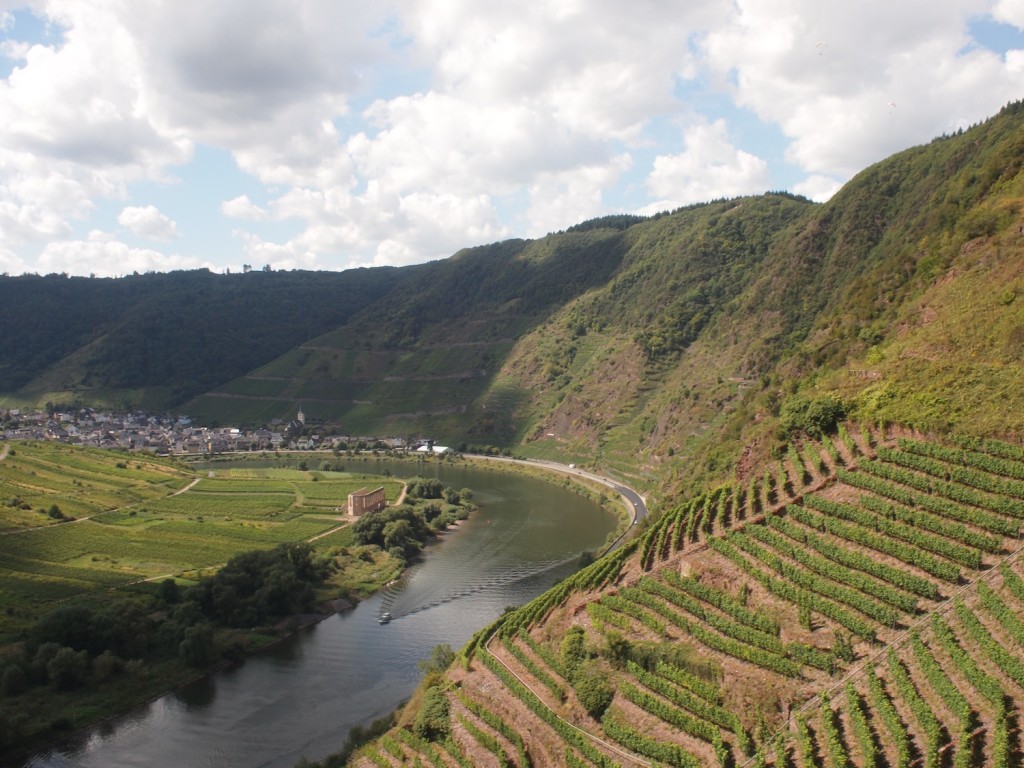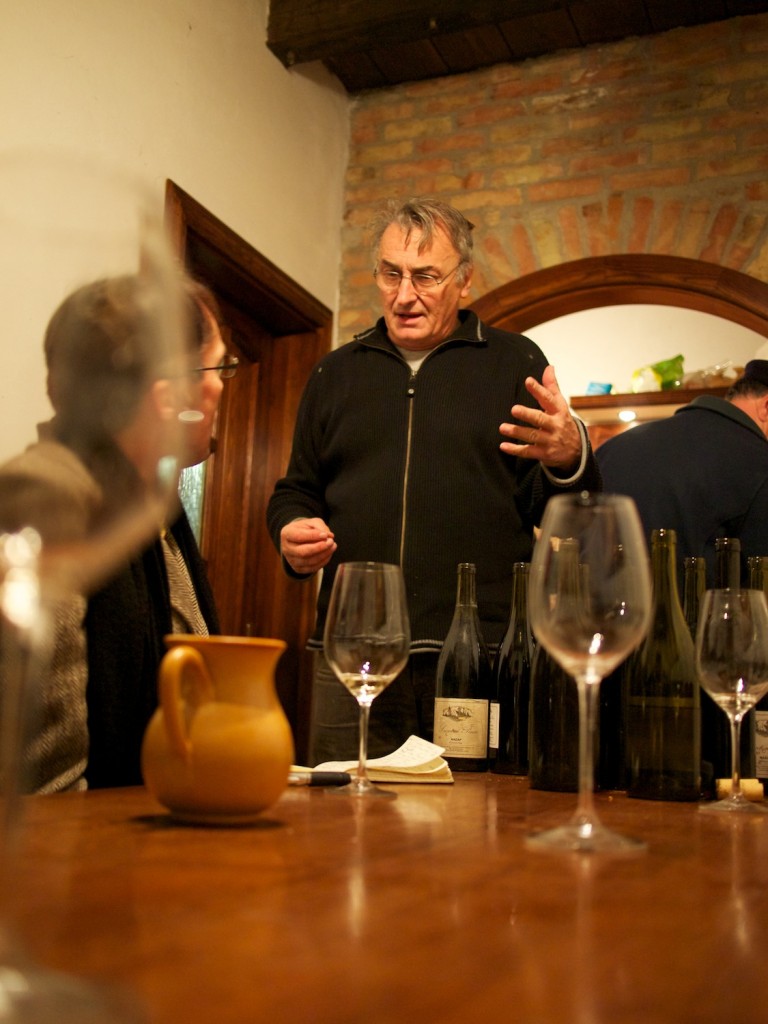There it is, a typical Riesling landscape, also a typical German wine landscape with those famous steep vineyards and a river at their foot, or? The Bremmer Calmont vineyard in the Mosel Valley pictured above is probably the steepest in the world and almost only Riesling grows there. Although this is the kind of scene many people picture when they think of Riesling it is only one of the extremely diverse Riesling landscapes in Germany and around the world.
Coming to New York has reminded me that when you’re inside a culture, then it’s really invisible to you. Only when you step outside it, with at least one foot, do you become aware of your own culture’s peculiar preconceptions. Then the very different assumptions of the culture into which you have moved can also be glaringly obvious. For many people this is all very disconcerting and I think that’s one thing behind the typical tourists obsession with “seeing the sights”, by which I mean seeing the things they’ve already seen in brochures, books and on the screen. They are comforting, because they seem familiar when a lot of other things are seriously unfamiliar. By the way, during my first week in New York I felt no need to see the State of Liberty, nor Ground Zero or even Central Park. (My mother and sister are visiting the next few days so this will change).
Back in Germany where I lived the last twenty years almost nobody who knows anything about wine would say that Riesling is necessarily a German wine, because there’s a widespread awareness of the Rieslings from Alsace in France and Austria. Many wine lovers know that Riesling also grows in a bunch of other countries scattered around Planet Wine. Welded to this knowledge is the Germans’ deep-seated wariness of claiming to own anything except their own personal possessions. This is, of course, a reaction to what happened in World War II when the Nazis claimed that great chunks of Europe belonged to Germany and felt they could therefore do whatever they wanted to the people who lived there (i.e. hard-core colonialism as practiced by other European nations elsewhere in the world during the 19th and 20th centuries).
In contrast, here in the US the idea that Riesling is per se a German wine is widespread, and I quite often encounter the prejudice that Riesling is not only German, but that it is also inevitably sweet and that this sweetness is a sign of its inferiority (in contrast for example to the noble dryness of the Holy Wines of Burgundy). If we’re honest with ourselves we all like to pigeonhole things and think in stereotypes to some degree. When it comes to wine many people have the correct gut feeling that geography influences the taste of wine, but then jump to the dubious conclusion that the wines of the world are best divided up by nationality. The desire for simplification in a world that is complex and therefore confusing is understandable, but when it comes to wine the result of country-shaped pigeonholes and one or two word description of their contents is often crude prejudices.
The other day when I thought back to what Jancis Robinson wrote about Riesling in her great new book ‘Wine Grapes’ I realized that I too had fallen into this trap. Mentally added up the figures for the area planted with Riesling in various European countries and it suddenly hit me that my assumption that the great majority of Rieslings in Europe grow in Germany was plain wrong. Part of the reason for my making this mistake is the difficulty of getting reliable up to date figures for the wine industries of certain countries. Jancis Robinson went to the trouble of doing so for all of Eastern Europe and her results (all figures for 2009) are well worth looking at.
In ‘Crazy Riesling Stats (2)’ I complained that I couldn’t find a reliable figure for the area of Riesling planted in the Ukraine. Well Jancis did and it’s 2,702 hectares, which is more than in the Rheingau/Germany or the whole of Austria! Then follows tiny wine-obsessed Moldova with 1,343 hectares and Hungary with 1,283 hectares. Unfortunately I don’t know any great Rieslings from Ukraine or Moldova, but the powerful yet lively dry Rajnai Rizling which József Szentesi is making are really exciting and distinctive. He’s quite a character as you can see below. The photograph was taken in Szentesi’s cellar on the southern edge of Budapest by Zoltan Heimann (many thanks) during our December 2010 tour of Hungary and Burgenland in Austria. This experience should have alerted me the fact that Eastern Europe has a significant Riesling production, but my mind was insisting on sticking with a set of familiar pigeonholes. Schmuck!
Reading in Jancis’ book that the Czeck replublic has 1,270 hectares of Rizlink Rynsky makes me determined to hunt down the good ones. I feel no different about Bulgaria with 1,170 hectares of Risling Croatia with 1,072 hectares of Rizling Rajinski. Slovakia has 998 hectares of Rzlink Rysky and at least one high-class (generally off-dry) Riesling from Kastiel Béla which is produced by the world-famous Saar Riesling producer Egon Müller. Then comes Russia where the Krasnodar region has 882 hectares of Riesling and Slovenia with 591 hetcares in the Slovenia part of Styria and 52 hectares elsewhere. By the way, those names are all correct synonyms for real Riesling!
According to Jancis Robinson’s ‘Wine Grapes there are at least 11,363 hectares of Riesling growing in Eastern Europe. If I then add the 3,382 hectares in France (nearly all in Alsace), the 1,874 hectares in Austria, the 624 hectares in Italy, the 159 hectares in Luxemburg and the 97 hectares in Spain (nearly all in Catalonia) this gives a total for Europe excluding Germany of 17,599 hectares. This is a shade too low, because there’s also small areas planted with Riesling in Switzerland, Portugal and the other Balkan countries. However, this is really not so far short of the 22,434 hectares growing in Germany. The truth is that by a small margin the majority of European Rieslings are German in origin, but on the other hand almost 45% of all European Rieslings are non-German. If we were to add to them the Riesling vineyards on the other continents, then Germany’s share would shrink to well below 50%.
The other half of the common American stereotype of Riesling is that in addition to being German it is sweet. Well, the latest statistics show that just shy of 70% of all German wines are either dry or just off-dry. That sweet prejudice strikes me as a projection of how things used to be upon a world that has long since moved on. Now’s a good time to catch up with reality and in this case the stats really help us to do that!



![120114_riesling_global_RZ [1600x1200]](http://www.stuartpigott.de/wp-content/uploads/2012/12/120114_riesling_global_RZ-1600x12002.jpg)
Stuart,
I did not see the article from Jancis. I too keep a tab on Riesling acreage but never was able to get eastern Europe. Would love to see her numbers. Below are mine:
Country Region Acreage Year reported
Germany Pfalz 13,756 2011
Germany Mosel 13,082 2011
Germany Rheinhessen 9,766 2011
France Alsace 8,372 2012
USA Washington 7,864 2012
Australia South Australia 7,213 2010
Germany Rheingau 6,108 2011
Germany Wurttemberg 5,098 2011
USA California 4,147 2011
Austria Niederösterreich 3,800 2009
Germany Nahe 2,829 2011
Germany Baden 2,805 2011
New Zealand New Zealand 2,493 2011
Canada Ontario 1,925 2012
Italy Italy 1,236 2012
Australia Victoria 1,102 2010
Australia New South Wales 1,008 2010
Chile Chile 823 2012
USA Oregon 797 2011
Germany Franken 788 2011
USA New York 785 2006
Germany Mittelrhein 759 2011
Australia Western Australia 692 2010
USA Michigan 595 2012
Germany Hessiche Bergstrasse 511 2011
South Africa South Africa 507 2011
Canada British Columbia 439 2011
Could you please help me, I have been given a bottle of Chateau Vrbanc Real Riesling from Zabok Region Croatia.
The back label says produced by Winery & Chateau Vrbanc, Donje Vino 38a, Kraponske Toplice, Croatia.As I like to have more details of wines, like taste notes etc, I just cannot fid anything o this wine, can you offer any help please.
Thanks
Neil London U.K.
Hi Niel, sorry that I can’t help you on this one. I am not familiar with Chateau Vrbanc and don’t know anyone I can ask about that wine. You have intrigued me though! Best wishes and many thanks, Stuart
Excellent web site. Plenty of useful information here.
I am sending it to some buddies ans additionally sharing in delicious.
And obviously, thank you to your effort!
Feel free to visit my web page شركة نقل اثاث